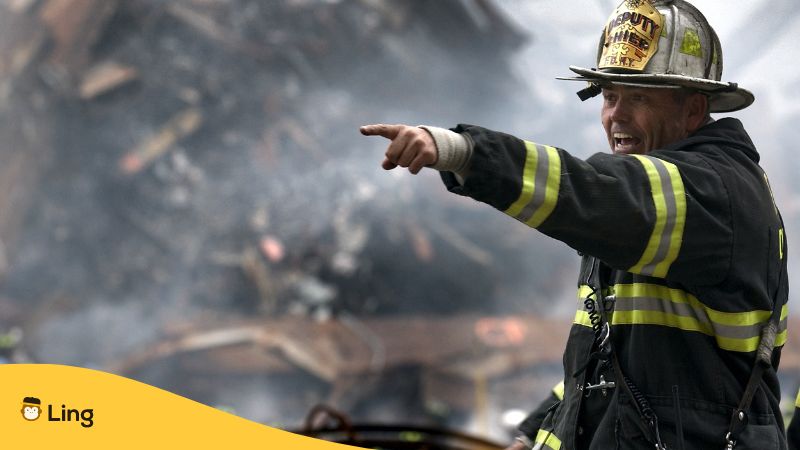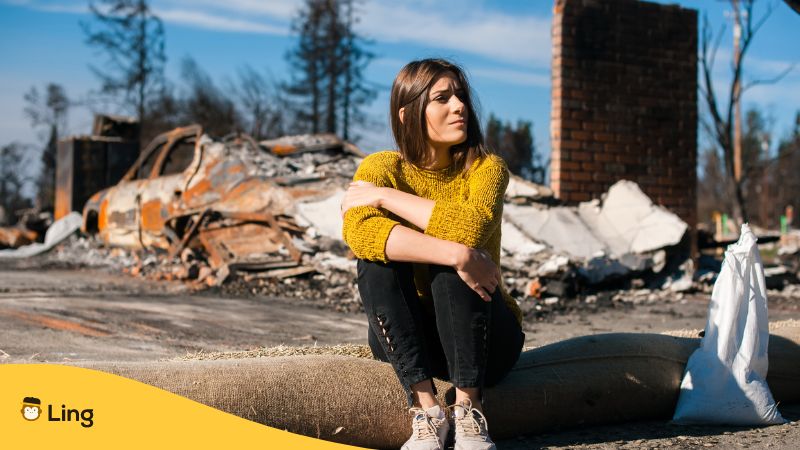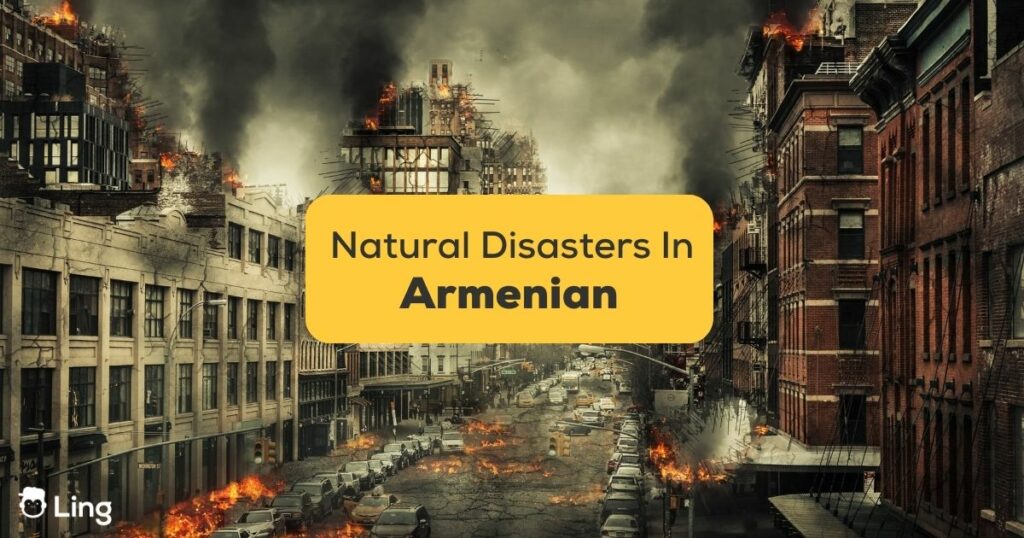So, you’re a traveler with an unquenchable thirst for embracing the unpredictable – riding the wave of adventure, cresting the peak of diverse cultures, and delving deep into linguistic mysteries. You’ve scaled towering mountains, glimpsed glittering cityscapes, survived the sun’s sizzle in deserts, and maybe even braved a storm or two. In this post, we’ll go over the Armenian disasters vocabulary to prepare you in case of Mother Nature-related emergency situations. Let’s begin!
As any seasoned traveler knows, a close encounter with Mother Nature’s capricious moods can add an unforgettable twist to your tales of adventure. For when in Rome, doing as the Romans do might mean learning to tango with an earthquake or learning to batten down the hatches in a storm. But what if the dance card is drafted in Armenian, and your trusty phrasebook has abandoned you?
As a fellow wanderer and polyglot, trust me – I’ve been there. And so, from one adventurer to another, let us arm you with the knowledge you need to face life’s meteorological curveballs head-on, all while savoring the linguistic richness of the Armenian language.

Armenian Disasters Vocabulary
Alright, fellow linguistic explorers, it’s time to roll up our proverbial sleeves and wade into the crashing waves of Armenian disaster terms. Don’t worry, this natural disaster tour is guarded by a team of phonetic lifeguards who will guide you safely to the shore of understanding. You ready? Let’s dive in!
Earthquake: Երկրաշարժ (yerkrasharj)
Let’s break some ground with ‘yerkrasharj,’ an intriguing blend of sounds that tells a seismic saga. It’s derived from ‘yerkr’ (Earth) and ‘sharj’ (move). According to the locals, the latest significant earthquake in Armenia occurred on February 13, 2022, in Metsavan. With a magnitude of 5.3, the tremors from this quake were felt across the country.
Flood: Ջրավախտք (jravakhtk)
Next, we navigate the waters of ‘jravakhtk,’ where ‘jra’ stems from ‘jur’ (water) and ‘vakhtk’ is inspired by ‘vakhutyan’ (destroy). The last major flood in Armenia took place back in 2010, causing an estimated USD 10 million in damage. These incidents highlighted the country’s vulnerability to large-scale flooding.
Landslide: Հողամասայր (hoghamasayr)
Due to the country’s mountainous terrain, landslides are considered a natural occurrence, especially after a typhoon. Another terminology related to this is Կարմրահրված (karmrahrvats), a geological jigsaw of ‘karmir’ (red, to symbolize the common color of landslide material) and ‘hrvatsum’ (pour out).
Thunderstorm: Ամպոց արձակում (ampots ardzakum)
‘Ampots ardzakum,’ a phrase as charged and exciting as a storm itself, stems from the blend of ‘ampots’ (cloud) and ‘ardzakum’ (discharge). Another word that is directly related to this is Քամութ (Kamut) – a word that buzzes with the sound of storm-whipped air and lashing rain that ‘hums’ its tempestuous lullaby.
Drought: Այրում (ayrum)
As arid as the condition it represents, ‘ayrum’ characterizes a long period without rain. Like a parched desert seeking an oasis, this word beckons for a few drops of ‘water’ of understanding. Armenia, like many nations, has experienced the impacts of climate change. Over the past two decades (1994-2014), drought was reported as one of the natural hazards leading to approximate losses of over 1.5 billion USD.
Monsoon: Մոնսուն (monsoon)
Next, ‘monsoon’ whispers tales of rhythmic rainfall and mesmerizing petrichor, the term is borrowed from the Arabic ‘mausim,’ signifying seasonal winds that bring rain. As a landlocked country, Armenia doesn’t dance to the monsoon’s annual rhythm, unlike its South Asian counterparts. However, the country does experience rainfall mainly during two distinctive seasons: spring (particularly April and May) and autumn (October and November).
Volcanic Eruption: Բրթության ժայթք (brtootyan zhaytk)
An ode to the Earth’s fiery rage – ‘brtootyan zhaytk,’ stitched from ‘brtootyun’ (explosion) and ‘zhaytk’ (outflow), plus a whole lot of magma. No need to don your heat-proof gear just yet—volcanic eruptions don’t currently sizzle in Armenia’s geology! However, just like in many regions of the world, the soil in some of Armenia’s southern mountains whispers tales of ancient volcanic activity. Alas, but for now, we won’t be witnessing a fiery spectacle gushing forth from the earth in Armenia.
Another term related to this devastating disaster is Լաւայի հոսք (lavayi hosk). This term refers to the flow of molten rock.
Giant Wave: Գերազանց ալիք (gerazants alik)
Borrowed from English, ‘gerazants alik’ captures the roaring majesty of towering ocean waves that surf above the rest. Landlocked and devoid of massive coastlines, Armenia isn’t a breeding ground for giant waves or tsunamis. Lake Sevan, the largest water body in the country, is more about serene lakeshores and a haven for aquatic biodiversity. So, rest easy, landlubbers! No towering waves are popping up on Armenia’s horizon anytime soon!
Hailstorm: Մարմար (marmar)
Next is ‘marmar,’ an onomatopoeic word that playfully mimics the sound of hailstones batting against the rooftops. In May 2015, it was reported that a hailstorm affected the vineyards in the Vayots Dzor region, leaving winemakers somberly counting their losses. One can only imagine the frustration of wineries as their precious grapes were blemished by the relentless downpour of icy pellets.

Planning A Trip? Here’s What You Should Know
Ah, Armenia! A land wrapped in centuries-old culture, nestled among captivating landscapes. But hold onto your hats, intrepid travelers, as this journey involves a tad more preparation than merely packing your suitcase. Before embarking, get familiar with some critical aspects of Armenia—starting from understanding the natural hazards that could make your trip, let’s say…more thrilling than expected.
Tip #1: Buddy Up With Earthquakes
Shake hands (pun intended) with the fact that earthquakes headline the list of natural hazards in Armenia. But before you let that ripple your excitement, remember Armenia has finely honed its disaster risk management game. They’ve taken the phrase ‘on shaky grounds’ to heart and used it to fuel their preparedness. Our advice? Try to get to know the basics of how to react in the case of an earthquake and the common phrases in the local language.
Tip #2: Dive Into Disaster Risk Reduction 101
A smart traveler knows all about their destination, whether it’s the best eateries, hidden gems, or a fundamental understanding of the local disaster risk reduction efforts. A bit of research before you jet off can provide you with that crucial edge to face Armenia’s occasionally thrill-centric climate. To help you in this aspect, make sure to remember the following numbers:
- Fire Service – 101
- Police – 102
- Ambulance – 103
Tip #3: Schools Aren’t Just For Learning
Armenia’s unique blend of cultural tradition and excelling in disaster-risk management isn’t the only juxtaposition you’ll find surprising. The proof of their commitment to safety? You’ll see it looming large among their school buildings!
These institutions, guardians of young minds, also reveal a country’s seismic safety secret. Did you know they are subjected to regular government scrutiny intended to ensure solid foundations and rigorous structural integrity? Fundamentally speaking, literally and figuratively, they transform into mini-fortresses capable of withstanding Mother Nature’s temper tantrums.
Tip #4: Stay A Step Ahead
It’s beneficial to keep abreast of local disaster response protocols via news reports, including potential evacuation procedures and emergency points of contact. That winning combo of local knowledge and preparedness could be your very own Armenian survival kit.
Tip #5: Engage With The Community
Let’s not forget the power of community—the Armenians challenge these risk factors head-on. Engage with them, learn their ways, and understand their disaster management protocols firsthand. Who knows, the best tips might come from a friendly local over a crisp Armenian lavash!
Learn Armenian With Ling
Having armed yourself with these guidelines and basic Armenian words for disaster, it’s now time to take that exciting leap into the breathtaking landscapes and vibrant culture of Armenia. But wait, there’s a final tip to sprinkle onto your Armenian cake—we know, we saved a cherry for last!
What better way to connect with the locals, navigate through an enchanting new terrain, and add another feather to your explorer’s hat than to grasp the local language? Yes, folks! You’ve guessed it right. Why not crack the linguistic code of the Armenians with the Ling app? The Ling app is your friendly language companion that’ll help break down the Armenian language into appetizing, bite-sized pieces. With this, you’re not just visiting Armenia but truly living the Armenian experience, one word at a time.
Give it a try today by downloading it from the App Store or Play Store for FREE!



































































